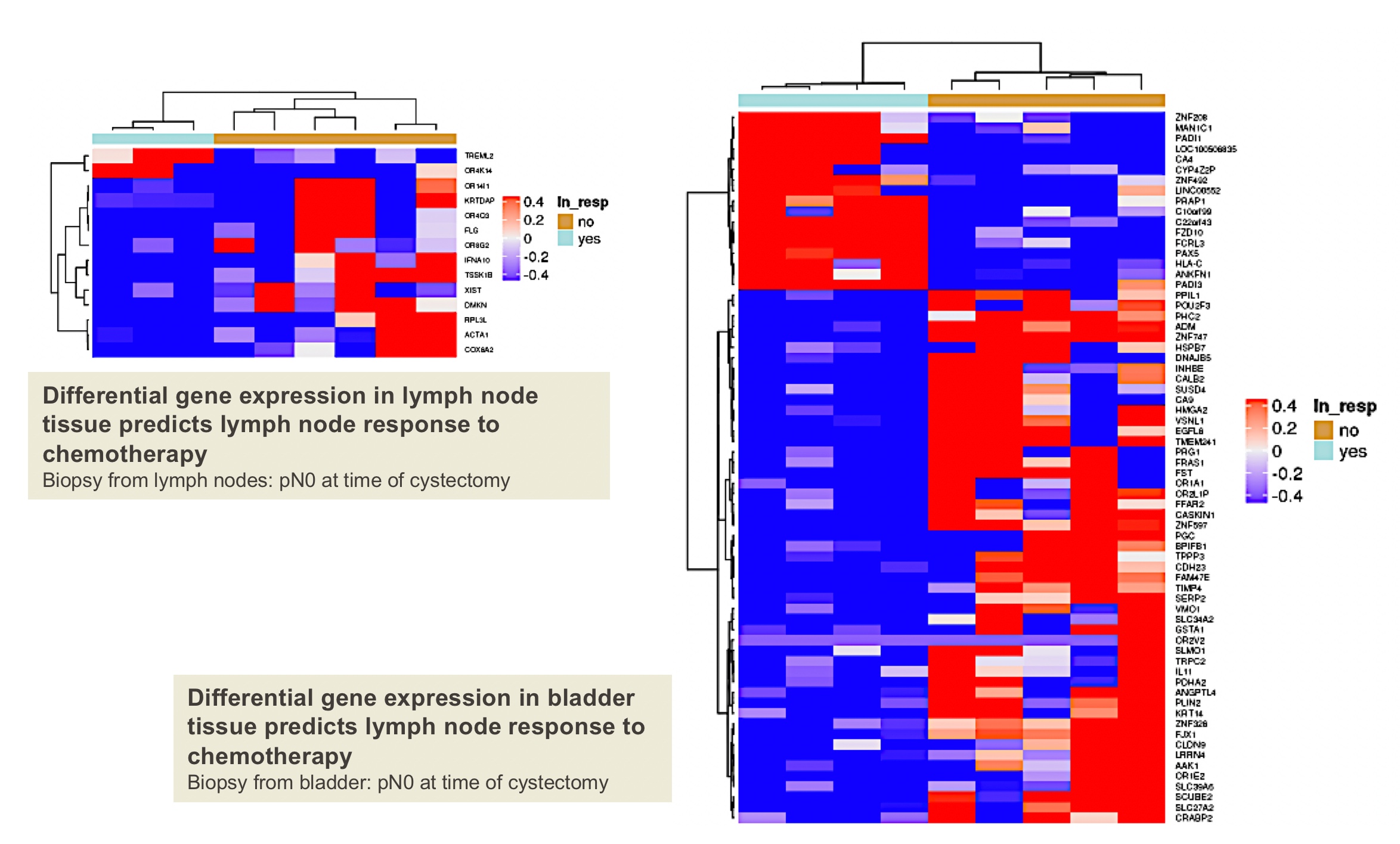Back
Introduction: Studies assessing the efficacy of preoperative chemotherapy in bladder cancer rarely include clinically node positive (cN+) patients. Further, the cN+ patients that are included are frequently categorized as cN+ based on imaging only. Therefore, true nodal response rates and oncological outcomes in this select patient group are generally unknown. Additionally, studies examining responder characteristics are lacking.
Methods: Data were collected retrospectively on patients with cTanyN1-3M0 bladder cancer who underwent radical cystectomy at the University of Texas MD Anderson Cancer Center (2006-2017). Complete nodal response (pN0) and bladder tumor response (pT0), recurrence free survival (RFS) and overall survival (OS) for patients with a positive lymph-node (LN) biopsy were recorded. Tissue mRNA microarray expression profiling was performed on LN and primary tumor tissue (pre-therapy) and compared among responders (pN0) and non-responders.
Results: Among the 120 patients identified with cTanyN1-3M0 disease, 26 (21.7%) patients had a positive LN biopsy. Induction chemotherapy was administered in all patients. Nine (34.6%) were pN0 and 9 (34.6%) were pT0 after primary chemotherapy. Seven were pT0N0. Lower stage disease on final pathology was associated with improved RFS and OS (p < 0.001). Fourteen differentially expressed genes in the LNs and 68 differentially expressed genes in the bladder were predictive of pN0 response to primary chemotherapy in the LNs (FDR <0.1; Figure).
Conclusions: Among cN+ patients, the true response rate to primary chemotherapy appears to be ~35%. Pathologic bladder response correlates well with nodal response. Finally, our study suggests that a panel of genes may be useful in distinguishing cN+ chemo-responders vs not, and thus could help reduce over- and undertreatment. These exploratory findings need prospective validation. SOURCE OF
Funding: None

Moderated Poster Session
Session: MP56: Bladder Cancer: Invasive IV
MP56-06: Pathologic Downstaging Rate and Predictive Biomarker Exploration in Patients with Biopsy-Proven Clinically Node Positive Bladder Cancer Undergoing Chemotherapy Followed by Radical Cystectomy
Sunday, April 30, 2023
9:30 AM – 11:30 AM CST
Location: S404C

Akshay Sood, MD
MD
THE UNIV OF TX MD ANDERSON CANCER CENTER
Poster Presenter(s)
Introduction: Studies assessing the efficacy of preoperative chemotherapy in bladder cancer rarely include clinically node positive (cN+) patients. Further, the cN+ patients that are included are frequently categorized as cN+ based on imaging only. Therefore, true nodal response rates and oncological outcomes in this select patient group are generally unknown. Additionally, studies examining responder characteristics are lacking.
Methods: Data were collected retrospectively on patients with cTanyN1-3M0 bladder cancer who underwent radical cystectomy at the University of Texas MD Anderson Cancer Center (2006-2017). Complete nodal response (pN0) and bladder tumor response (pT0), recurrence free survival (RFS) and overall survival (OS) for patients with a positive lymph-node (LN) biopsy were recorded. Tissue mRNA microarray expression profiling was performed on LN and primary tumor tissue (pre-therapy) and compared among responders (pN0) and non-responders.
Results: Among the 120 patients identified with cTanyN1-3M0 disease, 26 (21.7%) patients had a positive LN biopsy. Induction chemotherapy was administered in all patients. Nine (34.6%) were pN0 and 9 (34.6%) were pT0 after primary chemotherapy. Seven were pT0N0. Lower stage disease on final pathology was associated with improved RFS and OS (p < 0.001). Fourteen differentially expressed genes in the LNs and 68 differentially expressed genes in the bladder were predictive of pN0 response to primary chemotherapy in the LNs (FDR <0.1; Figure).
Conclusions: Among cN+ patients, the true response rate to primary chemotherapy appears to be ~35%. Pathologic bladder response correlates well with nodal response. Finally, our study suggests that a panel of genes may be useful in distinguishing cN+ chemo-responders vs not, and thus could help reduce over- and undertreatment. These exploratory findings need prospective validation. SOURCE OF
Funding: None

